- Community Home
- >
- Services
- >
- The Cloud Experience Everywhere
- >
- IaaS, PaaS and SaaS: The Cloud Comparison Guide [2...
Categories
Company
Local Language
Forums
Discussions
Forums
- Data Protection and Retention
- Entry Storage Systems
- Legacy
- Midrange and Enterprise Storage
- Storage Networking
- HPE Nimble Storage
Discussions
Forums
Discussions
Discussions
Discussions
Forums
Discussions
Discussion Boards
Discussion Boards
Discussion Boards
Discussion Boards
- BladeSystem Infrastructure and Application Solutions
- Appliance Servers
- Alpha Servers
- BackOffice Products
- Internet Products
- HPE 9000 and HPE e3000 Servers
- Networking
- Netservers
- Secure OS Software for Linux
- Server Management (Insight Manager 7)
- Windows Server 2003
- Operating System - Tru64 Unix
- ProLiant Deployment and Provisioning
- Linux-Based Community / Regional
- Microsoft System Center Integration
Discussion Boards
Discussion Boards
Discussion Boards
Discussion Boards
Discussion Boards
Discussion Boards
Discussion Boards
Discussion Boards
Discussion Boards
Discussion Boards
Discussion Boards
Discussion Boards
Discussion Boards
Discussion Boards
Discussion Boards
Discussion Boards
Discussion Boards
Discussion Boards
Discussion Boards
Discussion Boards
Community
Resources
Forums
Blogs
- Subscribe to RSS Feed
- Mark as New
- Mark as Read
- Bookmark
- Receive email notifications
- Printer Friendly Page
- Report Inappropriate Content
IaaS, PaaS and SaaS: The Cloud Comparison Guide [2018 Update]
Discover the definitions, benefits and use case for IaaS, PaaS and SaaS.
In 2021, cloud spending will be 45 percent higher than in 2016.
With increased demand for Infrastructure as a Service (IaaS), Platform as a Service (PaaS) and Software as a Service (SaaS), knowing exactly which is best for your organisation will help you make shrewder IT investments.
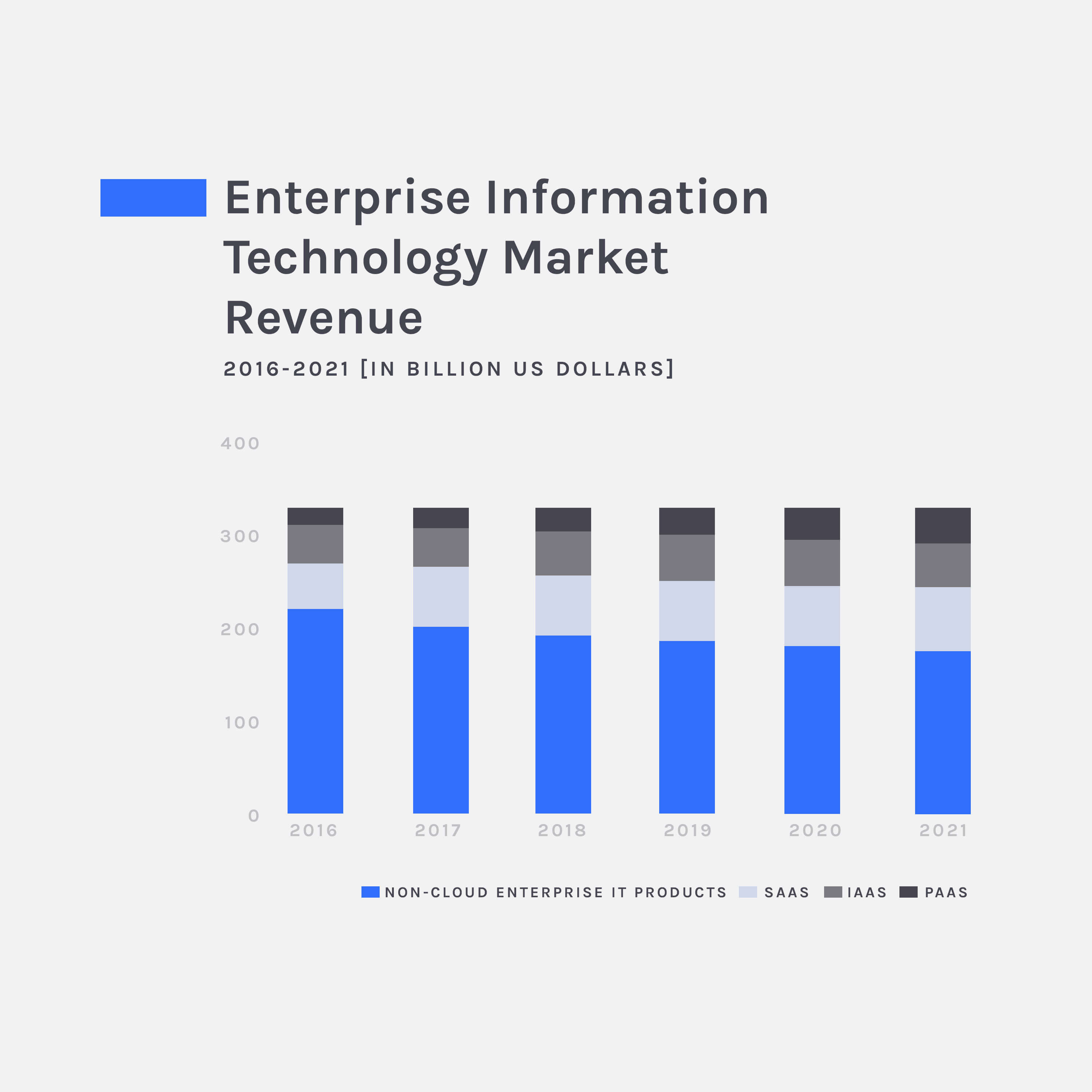 Enterprise cloud spending will reach $159 billion (£113 billion) in 2021.
Enterprise cloud spending will reach $159 billion (£113 billion) in 2021.
So, what are IaaS, PaaS and SaaS all about? And how can you cut through the industry jargon?
Let’s start with a brief definition of IaaS, PaaS and SaaS services:
- IaaS: Pay-as-you-go access to storage, networking and computing resources.
- PaaS: A cloud-based platform used to build, test and deliver applications.
- SaaS: Internet access to third-party software on a subscription basis.
As the responsibilities of the IT manager increase, our convenient guide will give you all the ammunition you need to analyse each service within the context of your own business. We’ll breakdown IaaS, PaaS and SaaS into their core components and discuss their benefits, use cases and popularity.
Everything as a Service: Examples of IaaS, PaaS and SaaS
Thirty years ago, all IT processes were run on rigid, on-premises systems.
But with the explosion of cloud computing, enterprises can now access infrastructure and resources on-demand as a service. IaaS, PaaS and SaaS dominate the modern market and each provides a different approach to IT management.
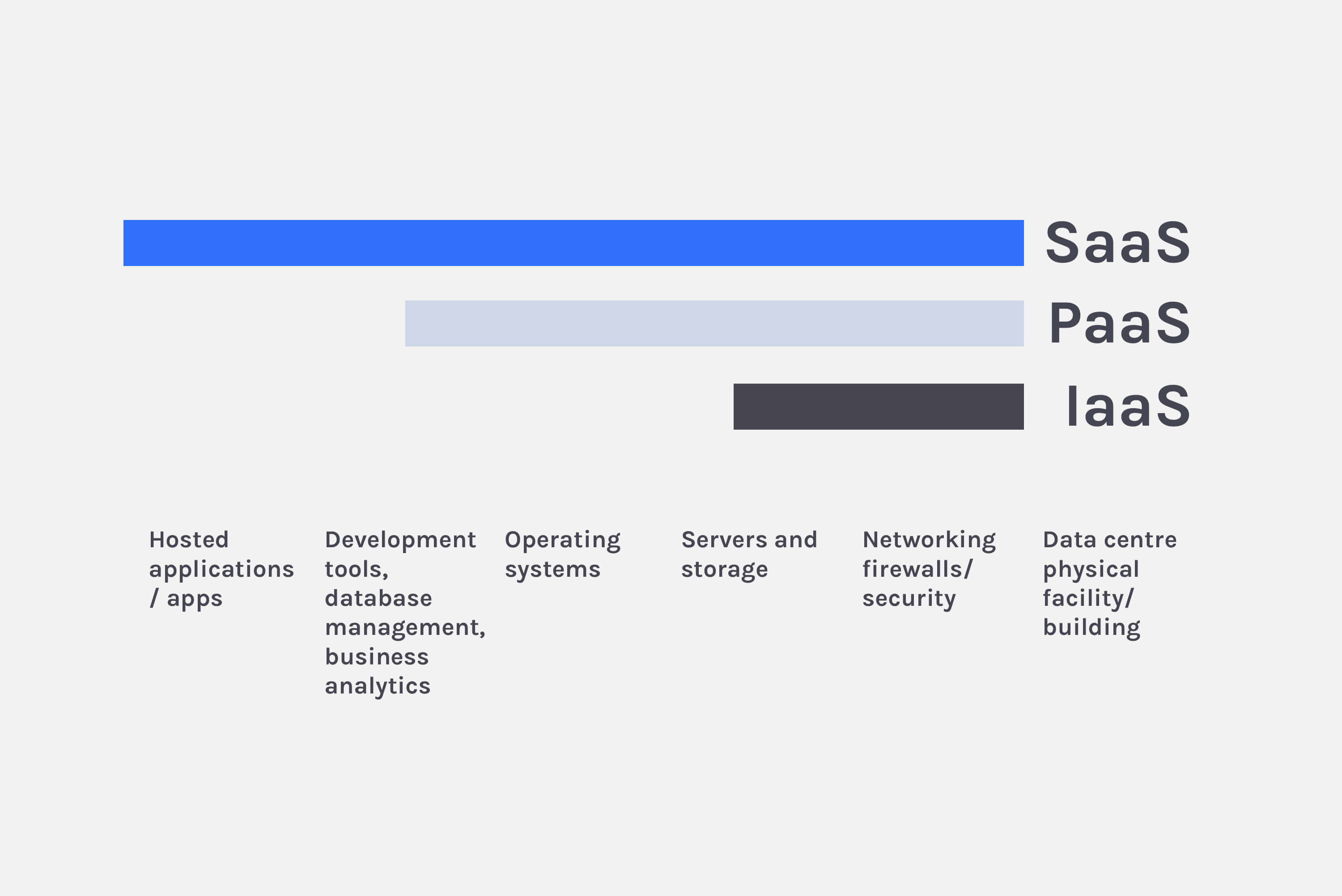
Infrastructure-as-a-Service [IaaS]
IaaS (or infrastructure-as-a-service) is your very own virtual data centre.
Instead of pumping money into in-house servers, you can rent them from a cloud service provider on a subscription basis. Around 12 percent of workloads are currently run on IaaS, according to 451 research (double the amount running in 2016).
IaaS solutions provide the underlying infrastructure for PaaS and SaaS applications, giving you the flexibility to configure and manage your own systems. By 2026, IaaS revenue is expected to rise to £107 billion, as more and more enterprises embrace a cloud-first approach.
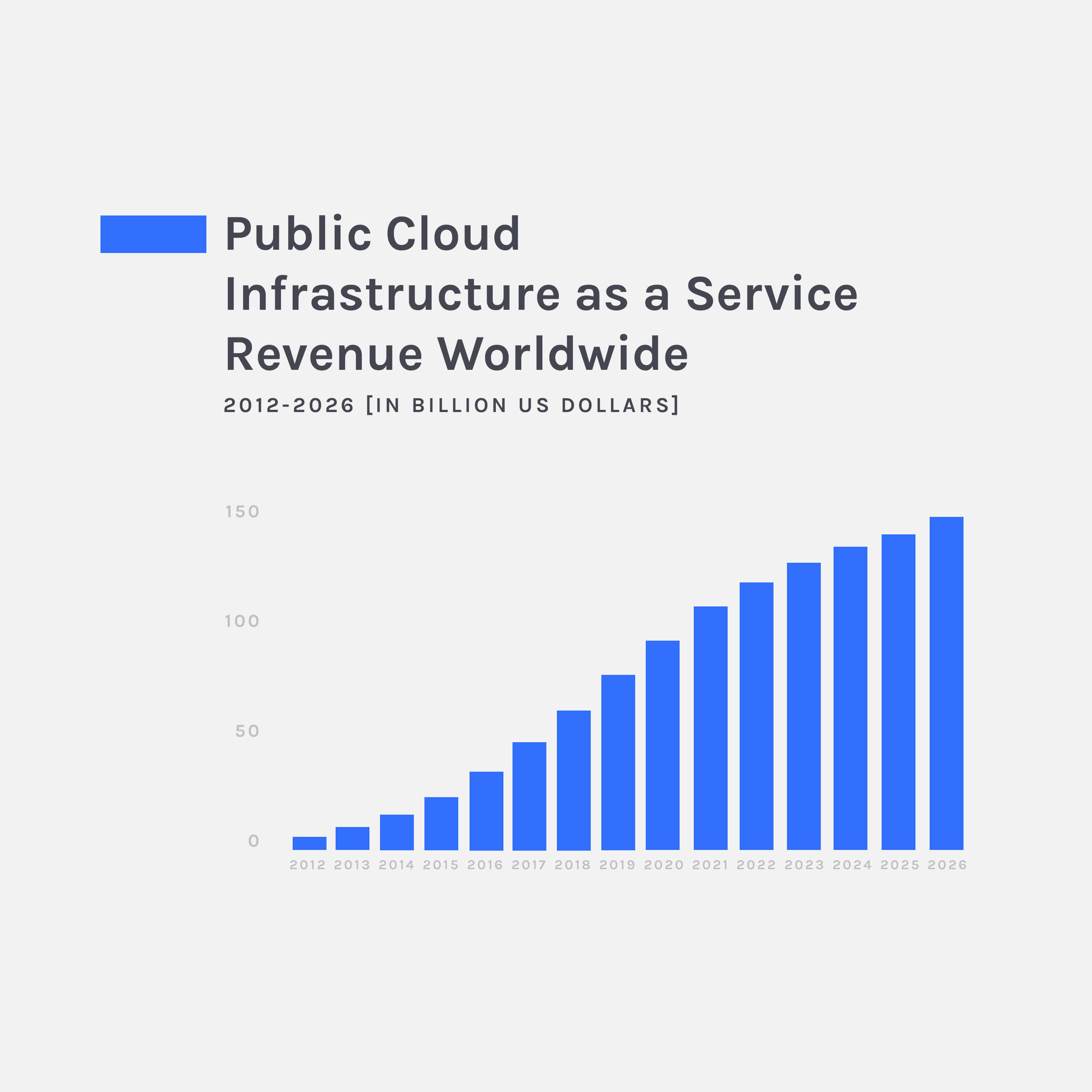 By 2026, IaaS revenue will reach $145.6 billion (£107 billion).
By 2026, IaaS revenue will reach $145.6 billion (£107 billion).
Managing Cloud Infrastructure-as-a-Service
First off, it’s important to distinguish between services that are managed by the provider and those managed by the customer.
As with all cloud technology, IaaS solutions are accessed over the internet from a cloud provider’s data centre. The chosen provider is responsible for the management and maintenance of traditional on-premises hardware (such as servers, storage and networking) and the virtualisation or hypervisor layer.
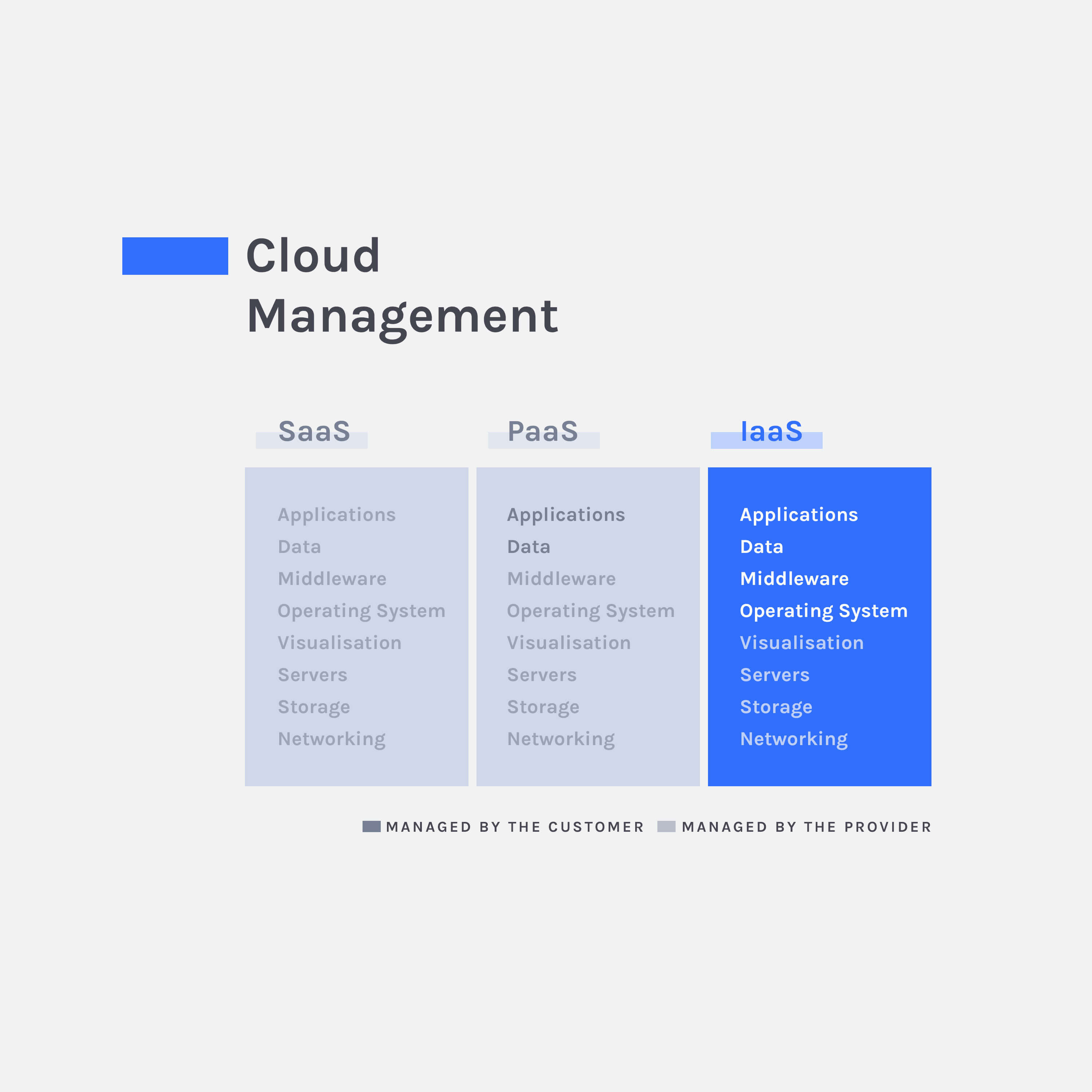
As well as provisioning hardware, IaaS providers offer key infrastructure services, including:
- Billing
- Network monitoring
- Security
- Disaster recovery
- Load balancing
With IaaS you can introduce a greater level of automation and orchestration to infrastructure tasks, making it easier to maintain application availability and performance. In general, organisations use IaaS solutions to:
- Spin up virtual machines
- Install operating systems
- Deploy middleware
- Create storage buckets and backups for workloads
IaaS Examples: What’s out there for your Enterprise?
There are a number of IaaS providers in the cloud computing market, but the three most notable are:
- Microsoft Azure
- Amazon Web Services
- Google Cloud
As a Microsoft Partner, we focus on Microsoft Azure IaaS solutions, but for an in-depth comparison of all three IaaS examples, check out our AWS vs Azure vs Google guide.
Azure IaaS can accelerate the performance of hybrid and cloud workloads in a number of different ways:
- Provision Windows and Linux virtual machines in minutes
- Reduce management overheads
- Guarantee uptime with SLAs
- Improve resilience, backup and disaster recovery
- Access built-in regulatory compliance
- Manage cloud and on-premises systems with the same tools
- Eliminate upfront capital costs - pay for what you use, when you use it
IaaS Benefits: Focus on the Tap, not the Plumbing
IaaS allows your IT team to focus on your core business rather than the underlying infrastructure.
While there are advantages to keeping some workloads on-premises, the scale and flexibility of the cloud make it ideal for test and development and high-performance calculations.
Amongst the key IaaS benefits are:
- Eliminating the upfront cost of managing and setting up an on-site data centre
- Maintaining direct access to servers and complete control of your data
- Improving business continuity and disaster recovery
- Deploying new infrastructure in minutes and rapidly test new ideas
- Responding quickly to evolving business demands with cloud elasticity
- Using service agreements to ensure better data security than in-house servers
However, since IaaS solutions involve multi-tenant architecture, it’s worth getting assurances about service availability before you commit to one particular provider.
Platform-as-a-service [PaaS]
PaaS (or platform-as-a-service) is a managed development and deployment environment in the cloud.
A PaaS provider delivers the hardware and software tools enterprises need to build and run applications in cloud datacentres.
Using the inherent elasticity of the cloud, PaaS solutions provide a scalable framework for developers to host and customise key services. Built-in features such as analytics and business intelligence help improve the functionality of these services, without the need to write huge amounts of code.
By 2026, the PaaS market will reach £34 billion.
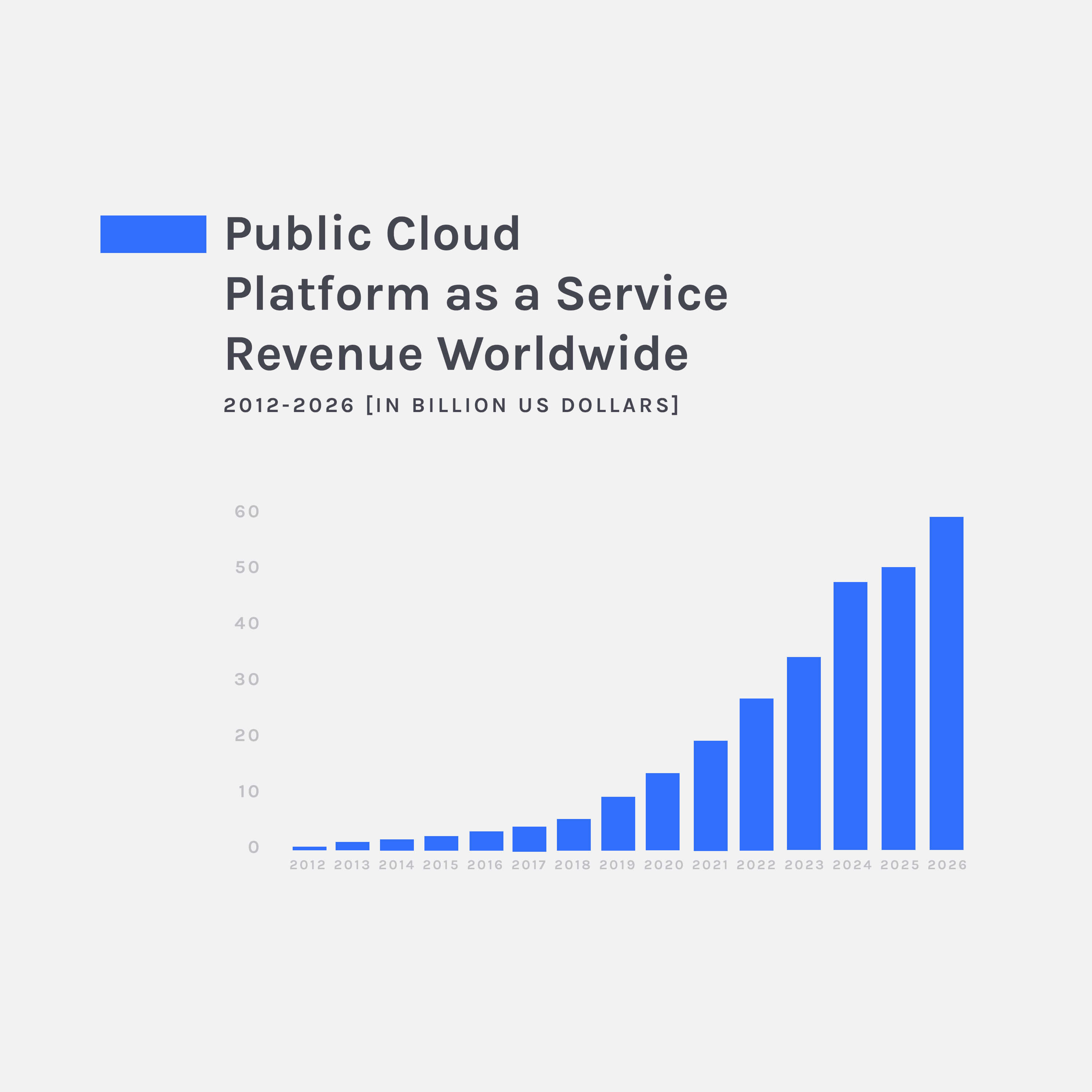 By 2026, PaaS revenue will reach $47.8 billion (£34 billion).
By 2026, PaaS revenue will reach $47.8 billion (£34 billion).
Managing cloud PaaS
As with IaaS, your chosen cloud provider delivers the underlying data centre infrastructure in a PaaS solution. On top of this, they also run and manage:
- The middleware
- Development tools
- Database management systems
- Business intelligence services
In short, you manage the applications and services you develop, while the PaaS provider deals with the rest.
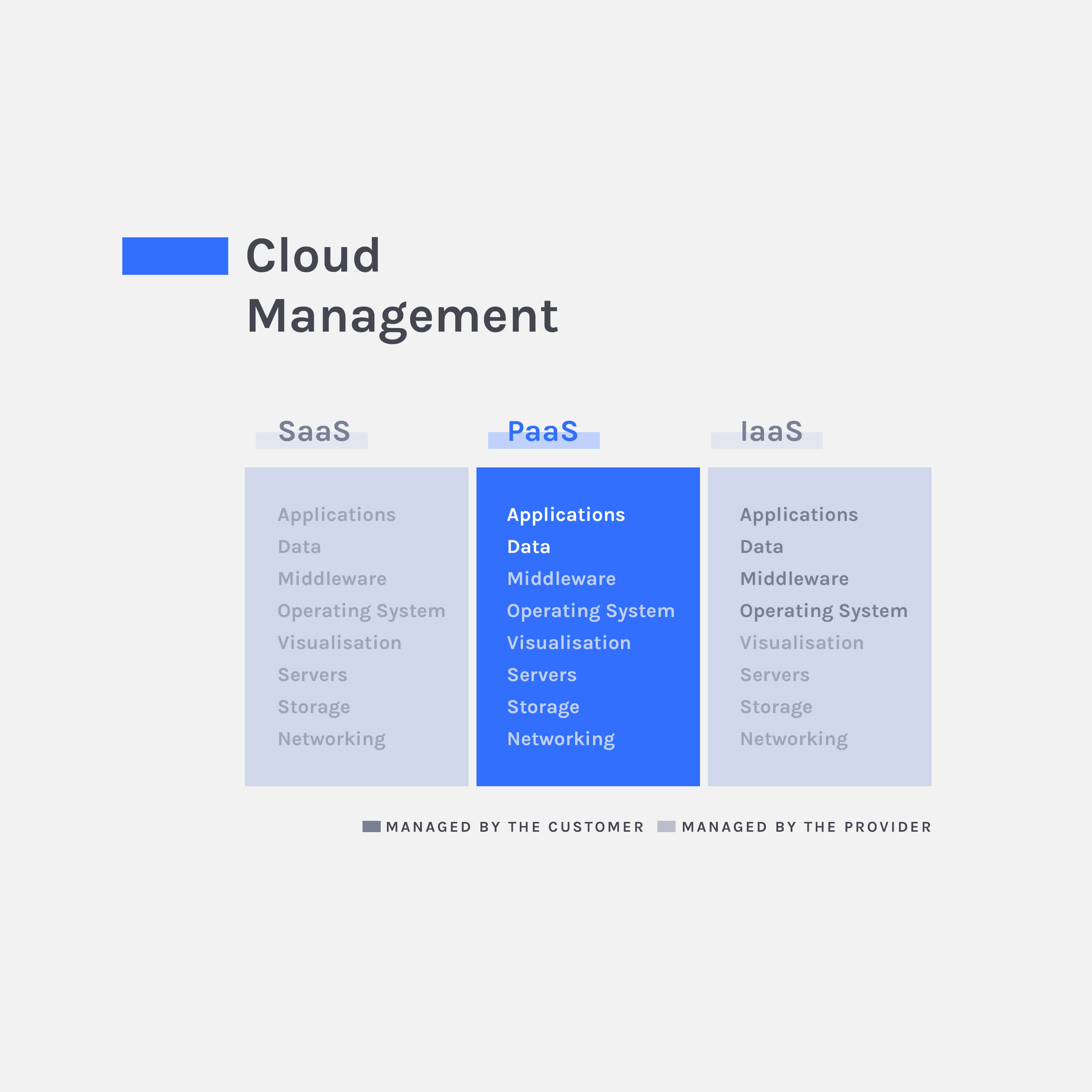
There are a few common scenarios businesses use cloud PaaS for:
- Application development – PaaS provides the tools developers need to build and customise cloud-based applications.
- Analytics and business intelligence – PaaS makes it easier to mine data, unlock insights and improve predictive forecasting.
- Microservices and APIs – PaaS reduces the burden microservice operations, using infrastructure-as-code to eliminate manual actions and increase runtime quality.
- Additional services – such as security, scheduling, workflow and directory.
PaaS Examples: What’s out there for your Enterprise?
There are many examples of PaaS throughout the cloud industry, with each provider offering a unique service roadmap and set of capabilities (including integrated programming languages and pricing models).
Three of the most notable PaaS solutions are:
- Microsoft Azure PaaS
- Google App Engine
- Red Hat OpenShift
Since each service offers slightly different capabilities, it’s important to test prospective providers and ensure they meet your business and technical requirements.
For example, Microsoft Azure PaaS provides an average ROI of 466 percent over a five-year period, reducing IT administration time by 80 percent. To achieve this, Azure PaaS services use familiar Windows tools to deliver secure development platforms and accelerate time to value.
PaaS Benefits: Cutting out the Middleware
As well as offering the same fundamental benefits as IaaS, cloud PaaS further simplifies the development process. PaaS benefits include:
- Lower software maintenance costs – PaaS operates on a pay-per-use model, meaning you can eliminate the cost of software licensing, yearly maintenance fees, patching and updates.
- Reduced coding time – application components (such as security, directory and search) come pre-coded and built into the platform.
- Multi-platform development – PaaS speeds up the time to market for cross-platform applications, enabling a consistent experience across desktop, web browser and mobile.
- Geographical support – internet access allows remote teams to work on the same project regardless of location.
- Efficient lifecycle management – build, test, deploy, manage and update web applications in the same integrated environment.
Software-as-a-service
Our third and final cloud service is the simplest of all. SaaS (or software-as-service) removes the need to install and run applications on-premises, offering them as a web service instead.
With a flexible pricing model, SaaS platforms eliminate the cost of acquiring, provisioning and maintaining the hardware needed to host business-critical software. For this reason, SaaS will make up 23 percent of all enterprise workloads by mid-2018.
Licensing, installation and support all come as part of the package in SaaS solutions, simplifying the tracking and management of subscription costs. This makes it ideal for enterprises looking to replace aging on-premises software with a cloud-based alternative.
In 2026, the SaaS market is expected to reach £234 billion – a 183 percent increase on 2018 figures.
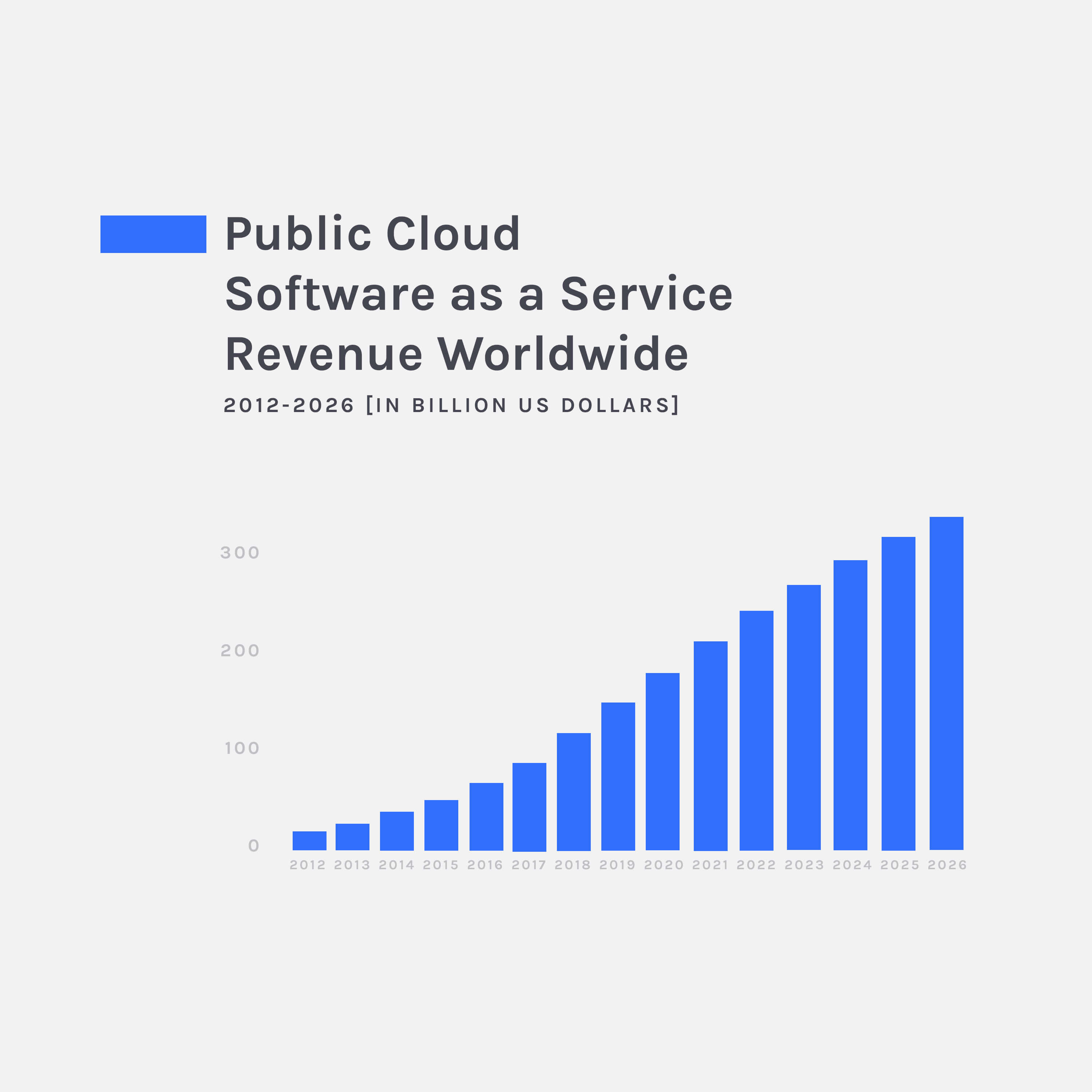 By 2026, SaaS revenue will reach $328.4 billion (£234 billion).
By 2026, SaaS revenue will reach $328.4 billion (£234 billion).
Managing Cloud SaaS
While there is virtually no in-house management with SaaS, there are a few things you need to consider. For one, understanding your SaaS provider’s service level agreement is vital to ensuring availability and recovering data in the case of a breach.
As with any platform, you’ll remain in charge of setting up and maintaining identity and access management (IAM), ensuring employee records are kept routinely up to date. Shadow IT is an increasingly issue in modern business, so keeping track of the services you’re subscribing to is crucial to retaining control.
You can also integrate SaaS applications with other software using APIs. Writing your own software tools in the cloud can be a great way to link compatible SaaS platforms with existing applications.
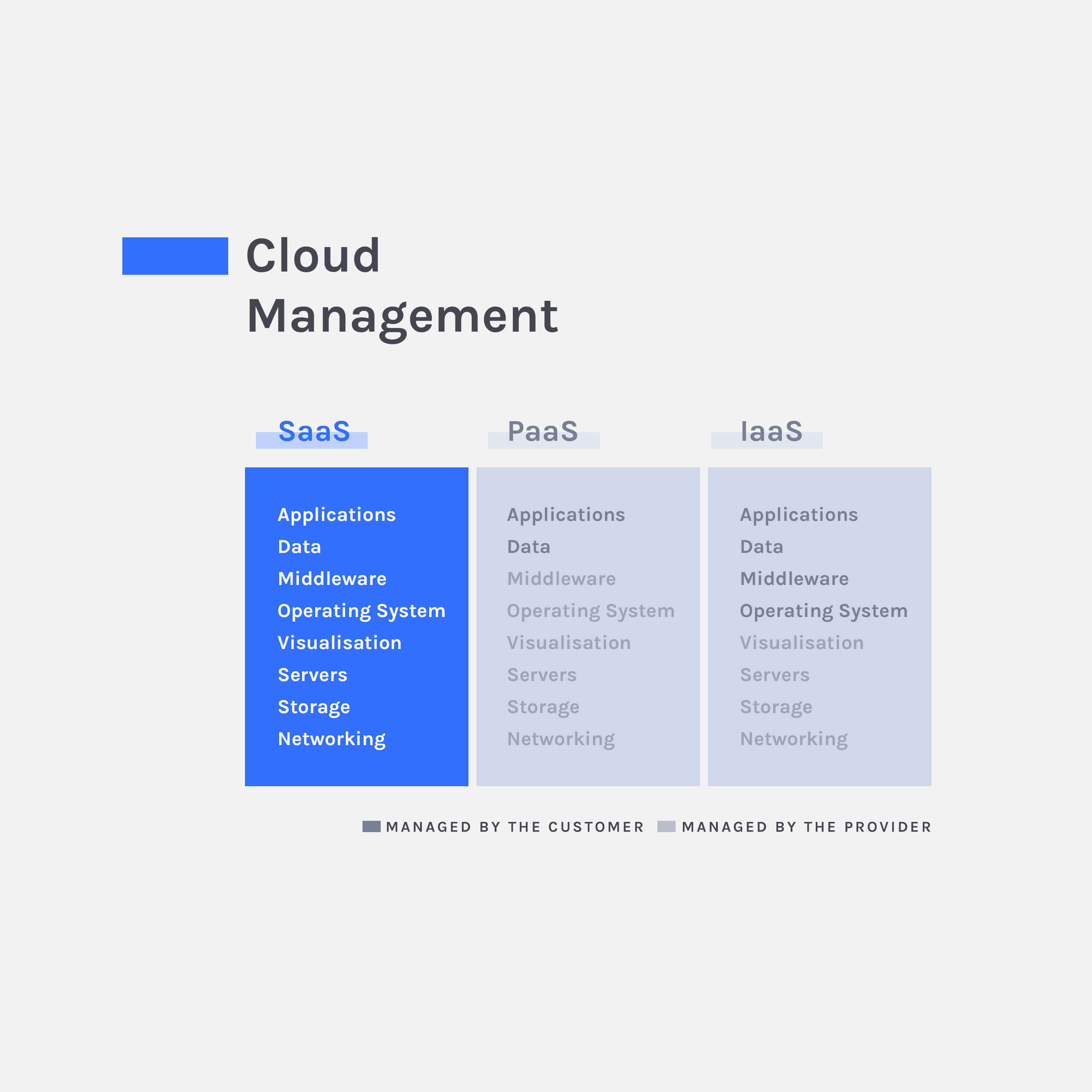
SaaS Examples: Who’s at the Top of their Game?
The top SaaS companies have carved out a niche in their market and used their agility to disrupt more traditional firms. Popular SaaS application examples include:
- Dropbox
- Office 365
- Salesforce
- Tableau
- Xero
We also offer our own SaaS platform, ACE (Azure Calculation Engine). ACE enables financial firms to run complex Excel workbooks using the flexibility of the Microsoft Cloud and improve the performance of mission-critical modelling applications. By switching to ACE, property management company, Telereal Trillium, saved more than £2.2 million over a five-year period.
SaaS Benefits: Enterprise Applications without the Upkeep
Unlike IaaS and PaaS, SaaS doesn’t require any technical skill or expertise and is designed with user-friendliness in mind. Here are the main SaaS benefits for your company:
- Zero installation and maintenance costs: the SaaS provider takes care of the heavy-lifting so you can focus on running your core business.
- Pay-per-use pricing: SaaS platforms scale up and down automatically depending on usage and usually involve a per-user pricing model.
- Web accessibility: you don’t need to download SaaS services to client devices. Access application any time through a secure web connection.
- Enterprise-grade software: SaaS makes it easier to deploy cutting-edge technology without the deployment and management overheads seen on-premises.
- Remote access: with the right SaaS provider you can mobilise your workforce and offer a secure service across any device.
SaaS, PaaS and IaaS Comparison: Which Solution is Best?
There’s no doubting the dominance of cloud computing, with 94 percent of enterprise workloads headed for the cloud in 2021. But the question of which cloud service you choose remains a little less clear cut.
As a quick roundup - feel free to check out this infographic:
When deciding between IaaS, PaaS and SaaS you need to take into account the specific workloads you’re migrating and the key business outcomes you’re hoping to achieve.
Let’s take a closer look at when you might use each of the services in your organisation:
Software-as-a-Service
- For applications that aren’t business-critical such as email or financial software.
- For rapid service deployment with little need for software customisation or specific infrastructure requirements.
- For highly collaborative, short-term projects between remote teams.
- For easy application access across both web and mobile.
Platform-as-a-Service
- For projects where multiple developers are working on the same application.
- For any project where a high level of customisation is needed.
Infrastructure-as-a-Service
- For rapidly growing companies that don’t want to commit to infrastructure investments.
- For developing and testing a minimal viable product (MVP) at speed.
- For applications with unpredictable or seasonal workload demands where flexibility and elasticity are key.
- For organisations looking to pay on a consumption basis without sacrificing control.
Summary: What does the Future hold for Cloud Services?
IaaS, PaaS and SaaS are all expected to grow in popularity over the coming years, with a shift away from testing and development-only deployments to a more permanent cloud-based infrastructure.
| PaaS | SaaS | IaaS |
| Applications | Applications | Applications |
| Data | Data | Data |
| Middleware | Middleware | Middleware |
| Operating System | Operating System | Operating Sytem |
| Visualisation | Visualisation | Visualisation |
| Servers | Servers | Servers |
| Storage | Storage | Storage |
| Networking | Networking | Networking |
Managed by the customer / managed by the provider.
As technology enablement accelerates processing power, storage, memory networking and security, more companies will look to long-term IaaS and PaaS solutions, with trust in public cloud services increasing.
Currently compute and collaboration drive the majority of cloud deployments and will continue to do so over the next five years.
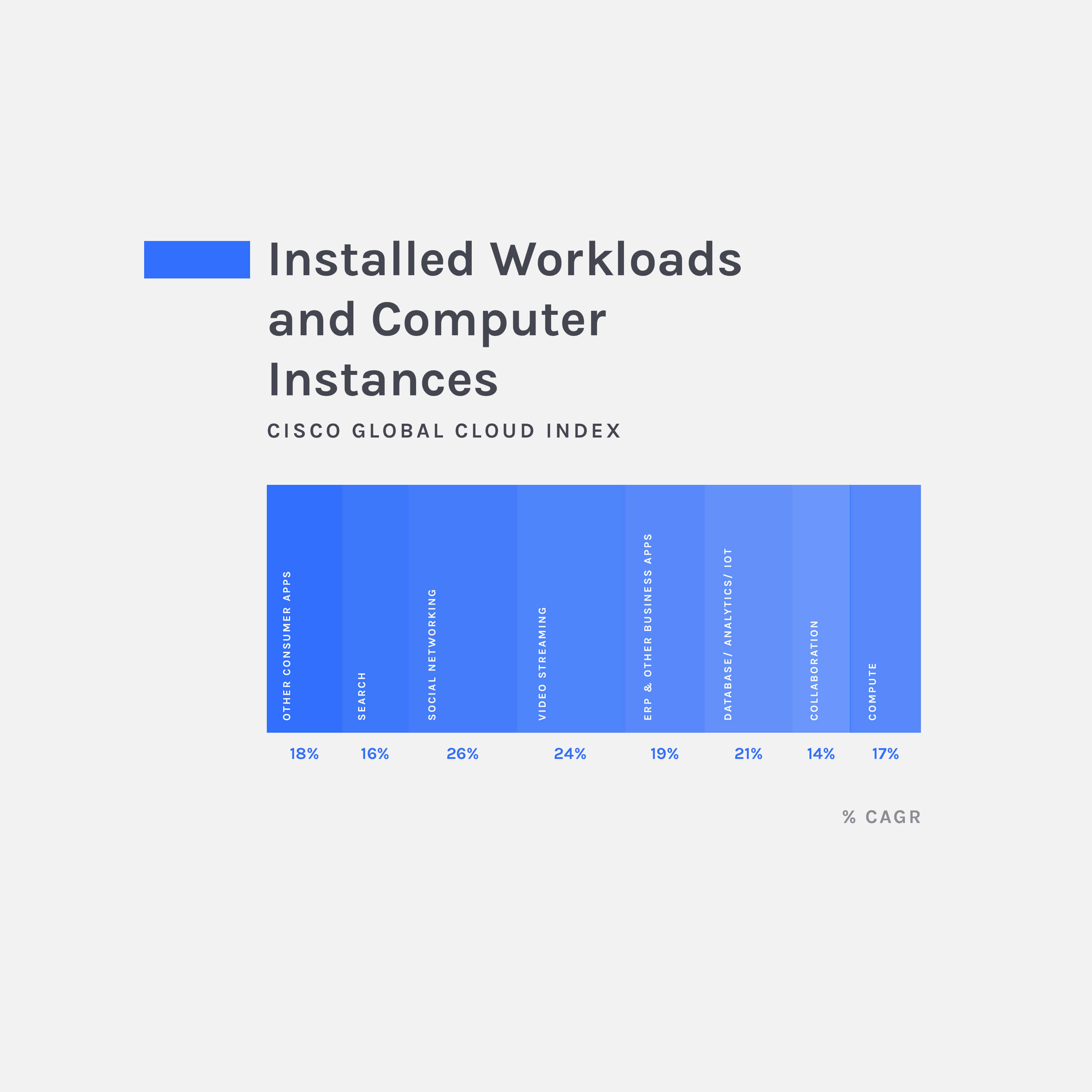
For organisations looking to move to workloads to cloud or a hybrid cloud environment, it’s worth taking the time to assess the best option for each and outline how IaaS, PaaS or SaaS will help you reach your business goals.
For more on cloud migration and the ways Azure can revolutionise your business, discover how we approach hybrid cloud in the financial sector.
- Back to Blog
- Newer Article
- Older Article
- Deeko on: The right framework means less guesswork: Why the ...
- MelissaEstesEDU on: Propel your organization into the future with all ...
- Samanath North on: How does Extended Reality (XR) outperform traditio...
- Sarah_Lennox on: Streamline cybersecurity with a best practices fra...
- Jams_C_Servers on: Unlocking the power of edge computing with HPE Gre...
- Sarah_Lennox on: Don’t know how to tackle sustainable IT? Start wit...
- VishBizOps on: Transform your business with cloud migration made ...
- Secure Access IT on: Protect your workloads with a platform agnostic wo...
- LoraAladjem on: A force for good: generative AI is creating new op...
- DrewWestra on: Achieve your digital ambitions with HPE Services: ...




